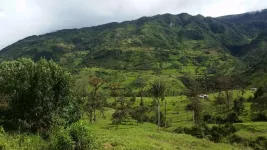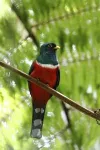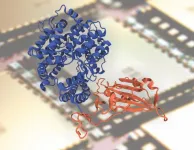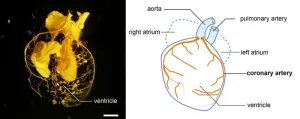(Press-News.org) Birds native to the tropical Andes, many of which cannot be found anywhere else, are threatened by increasing agricultural development in the region. A new study details how the resulting habitat loss affects specific species and lays out possible ways to protect birds from human-driven disturbance.
The researchers combined a meta-analysis of papers on birds across the Andes with five years of fieldwork in Peru, revealing that open farmlands result in up to a 60% decline in the number of species in an area. Before this work, there was little data on which species were declining or by how much.
“The vast majority of species that we’re working with in Peru have never been studied like this before,” said lead author Ian Ausprey, a postdoctoral researcher at the University of Bern and former doctoral student with the Florida Museum of Natural History. “Before, you couldn’t say whether a species was sensitive to disturbance or not because we really didn’t know.”
The different habitats and diets of each species — like whether a bird forages on the ground for seeds or feeds on insects in the canopy — means they will have different conservation needs. This paper documents how specific species are affected and provides tailored guidance to conservationists.
The tropical Andes are a biodiversity hot spot and home to over 1,500 bird species. Many are adapted to a narrow range of environmental conditions, making them particularly vulnerable to disturbance. Ausprey and co-author Felicity Newell, a postdoctoral researcher and former doctoral student with the Florida Museum, sought to understand the relationship between avian diversity and the type of habitat birds live in.
To do this, they conducted extensive field surveys in Peru while living and working with community members over several visits between 2014 and 2019. During that time as embedded researchers, they surveyed the bird communities in a variety of landscapes, from forests untouched by agricultural development to silvopastures — land used simultaneously to grow vegetation and graze livestock.
The researchers combined three sampling techniques: point count surveys, which rely on the ear to listen for bird calls and accounted for 90% of detections; flock surveys, a visual technique that works well for birds that fly in large groups but may not sing much; and mist-netting, which safely catches birds in the understory and works especially well for hummingbirds. These complementary methods paint a fuller picture of the tropical Andes’ birds and where they are found.
Ausprey and Newell spent five years working on the study, sometimes staying in Peru for six months at a time to conduct surveys during both the wet and dry seasons. They timed their trips to overlap with the peak breeding season, when birds are most vocal and therefore easier to detect. Their results showed that species richness, or the number of different species in the landscape, declined as much as 93% from forests to open pastures. They also found, however, that species richness on highly developed land could be increased by 18% to 20% with 10 additional silvopasture trees or 10% more fencerows per hectare.
Ausprey and Newell supplemented their findings with a literature review of studies on Andean forest birds in disturbed landscapes. Analyzing 14 studies representing 816 species, they found that species feeding primarily on insects and fruits were the most vulnerable. Highly specialized species, such as those adapted for narrow elevation bands or small geographic ranges, were also particularly sensitive.
One such bird is the endangered Lulu’s tody-flycatcher (Poecilotriccus luluae), a small and colorful bird with a limited geographic range in northern Peru. It prefers the shrubby type of landscape that forms in the 15 to 30 years after a pasture is abandoned and vegetation begins to grow back.
“Knowing what area to conserve for that species is important information,” Newell said. “Some of it is known already, anecdotally, but this quantitatively shows that that species uses this type of habitat.”
The researchers recommend sparing forest fragments — the larger the better — since any mature forests left standing act as reservoirs for forest bird diversity. They also suggest ways to mitigate the effect of land development by leaving some trees untouched in grazing pastures and maintaining shrubby habitats like those preferred by the Lulu’s tody-flycatcher.
While climate change is also transforming forests, in this study the authors chose to focus on shifting agriculture, which they say is the major driver of deforestation in the region. It is also showing few signs of slowing down.
“If there's no forest or the forests are too small to sustain organisms, then we're going to lose these birds regardless of what happens with the climate,” said Scott Robinson, senior author of the study and the Ordway eminent scholar at the Florida Museum.
In the tropical mountains of Latin America, deforestation is primarily driven by single families trying to support themselves by planting crops and raising livestock. The resulting landscape is a patchwork of forest fragments, shrub habitats, cattle pastures and small homes with vegetable gardens. Ausprey and Newell lived and worked directly with community members and local conservation advocates to gather data and conduct field surveys.
“Their lives are based in those landscapes, and they have a lot of appreciation for the nature there,” Ausprey said. “We hope that these results will inform their decision-making in the future so that they can have high quality standards of living while also maintaining a high level of biodiversity in their backyards.”
These results form the foundation of a more comprehensive database on how bird species in the Andes respond to human disturbance. In the future, Ausprey and Newell hope to apply these principles to other ecosystems and learn how climate extremes will play a factor. They are already monitoring changes to rainfall patterns, which are harmful to insect populations and may have cascading effects on birds that feed on bugs.
“This is really just a start,” Newell said. “There are tons of data-deficient species across the Andes and across the tropics in general, where we really don't know how species are responding to land use or climate change or other anthropogenic disturbances.”
The study was published in the journal Conservation Biology.
END
Hundreds of Andean bird species at risk due to deforestation: New research shows how to protect them
2023-08-22
ELSE PRESS RELEASES FROM THIS DATE:
Pacific coral reef shows historic increase in climate resistance
2023-08-22
Coral reefs in one part of the Pacific Ocean have likely adjusted to higher ocean temperatures which could reduce future bleaching impacts of climate change, new research reveals.
A Newcastle University-led study focused on the Pacific Island nation of Palau and has shown that historic increases in the thermal tolerance of coral reefs are possible. The results demonstrate how this capacity could reduce future bleaching impacts if global carbon emissions are cut down.
Drawing on decades of field observations, the scientists modelled many possible future coral bleaching trajectories for Palauan reefs, ...
Researchers extract ancient DNA from a 2,900-year-old clay brick, revealing a time capsule of plant life
2023-08-22
For the first time, a group of researchers have successfully extracted ancient DNA from a 2,900-year-old clay brick.
The analysis provides a fascinating insight into the diversity of plant species cultivated at that time and place, and could open the way to similar studies on clay material from other sites and time periods.
The results are published today in Nature Scientific Reports.
Currently housed at the National Museum of Denmark, the clay brick originates from the palace of Neo-Assyrian king Ashurnasirpal II, in the ancient city of Kalhu. Known today as the North-West palace in Nimrud (modern-day northern Iraq), its construction began around 879 BCE. ...
Exascale revolution: Supercomputers unleash a new era in biophysics discovery
2023-08-22
In a recently published article featured on the cover of the Biophysical Journal, Dr. Rafael Bernardi, assistant professor of biophysics at the Department of Physics at Auburn University, and Dr. Marcelo Melo, a postdoctoral researcher in Dr. Bernardi's group, shed light on the transformative capabilities of the next generation of supercomputers in reshaping the landscape of biophysics.
The researchers at Auburn delve into the harmonious fusion of computational modeling and experimental biophysics, providing a perspective for a future in which discoveries ...
Origins of coronary arteries
2023-08-22
Coronary arteries are a vital part of the human heart, providing it with oxygen-rich blood so that it can work. By comparing the hearts of mammals, birds, reptiles, fish and frogs, a multi-institutional team of researchers appears to have found evidence that the structure of our hearts evolved in a stepwise process from fish, through amphibians to reptiles to mammals. When animals evolved from living in the water to living on land, a significant remodeling of the blood vessels to the heart occurred, enabling survival without gills. Understanding ...
Novel research reveals existence of altered mesocortical connectivity in obesity
2023-08-22
ROCKVILLE, Md.—For the first time, researchers have discovered that the ventral tegmental area (VTA) of the brain—a key structure involved in motivation and reward appreciation has altered connectivity patterns with specific brain regions in patients with obesity. Individuals with obesity have hyper-connectivity of the VTA with part of the ventral occipitotemporal cortex (visual processing for food images) and hypo-connectivity with the left inferior frontal gyrus (associated with cognitive control), according to a new study in Obesity, ...
Study confirms long-term benefits of weight loss surgery in the prevention of cancer
2023-08-22
ROCKVILLE, Md.—After adding follow-up years, increased sample sizes and examining multiple surgical procedures, new research shows bariatric surgery is associated with lower all-cancer and obesity-related cancer incidence among females. The research also found that cancer mortality was significantly lower among female surgical patients compared to non-surgical subjects, according to a new study in Obesity, The Obesity Society’s (TOS) flagship journal.
Although population studies have established a positive association between body mass index and cancer incidence, less clear is whether voluntary ...
Heart attack patients should take aspirin to avoid a new heart attack, stroke and death
2023-08-22
Amsterdam, Netherlands – 22 Aug 2023: Heart attack patients who do not take daily aspirin have an elevated likelihood of recurrent myocardial infarction, stroke or death compared with those who consistently take the drug, according to research presented at ESC Congress 2023.1
“Our findings suggest that not taking aspirin as prescribed after a heart attack is linked to a higher risk of having another heart attack, a stroke or dying,” said study author Dr. Anna Meta Kristensen of Bispebjerg and Frederiksberg Hospital. Frederiksberg, Denmark. ...
Heart attack victims who recognise symptoms are less likely to die in hospital
2023-08-22
Amsterdam, Netherlands – 22 Aug 2023: Recognising and acting on heart attack symptoms is linked with faster life-saving treatment, according to research presented at ESC Congress 2023.1
“Patients with a repeat heart attack were more likely to know the symptoms than first-time sufferers, but recognition was low in both groups,” said study author Dr. Kyehwan Kim of Gyeongsang National University Hospital, Jinju, Republic of Korea. “Most patients could identify chest pain but less than one-third knew the other symptoms.”
Heart attack symptoms can include chest pain, radiating pain to the arms, jaw and neck, dizziness, ...
Keep fit to avoid heart rhythm disorder and stroke
2023-08-22
Amsterdam, Netherlands – 22 Aug 2023: A study in more than 15,000 people has found that physical fitness is linked with a lower likelihood of developing atrial fibrillation and stroke. The research is presented at ESC Congress 2023.1
Atrial fibrillation is the most common heart rhythm disorder, affecting more than 40 million people worldwide.2 It is estimated that one in three Europeans will develop atrial fibrillation in their lifetime. Patients with the condition have a five-fold higher risk of stroke ...
City-living may make male song sparrows more doting ‘super’ fathers
2023-08-22
When animals settle in new environments, or when their natural habitats are rapidly changed by human influence, their behaviors change. One such behavioral change that has been observed in several bird species that settled in cities is increased aggression, born out of the need to defend territories.
City-living sparrows have, due to lower species density, fewer encounters with their kin than in the countryside. Yet, urban song sparrows have been shown to be consistently more aggressive in defending their territories. Now, a team of researchers in the US has investigated the effects of urbanization and the associated ...





